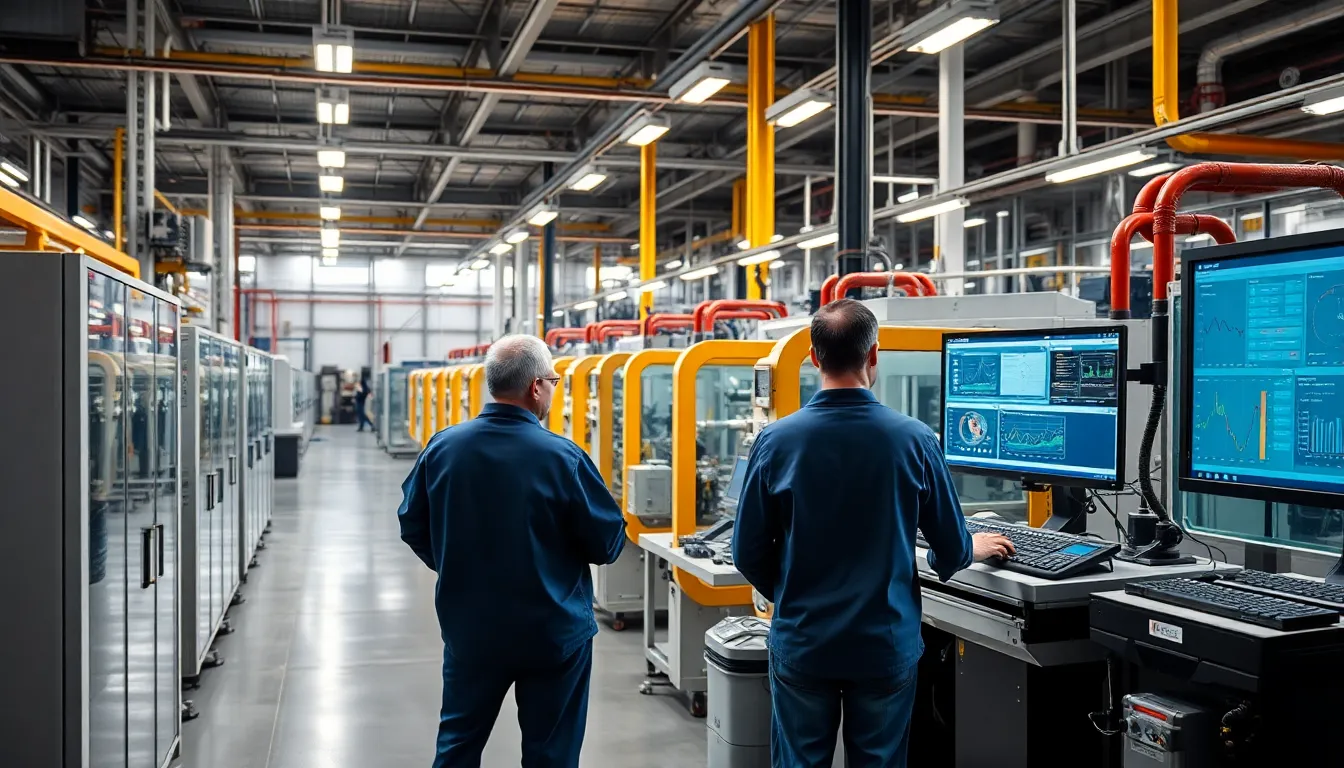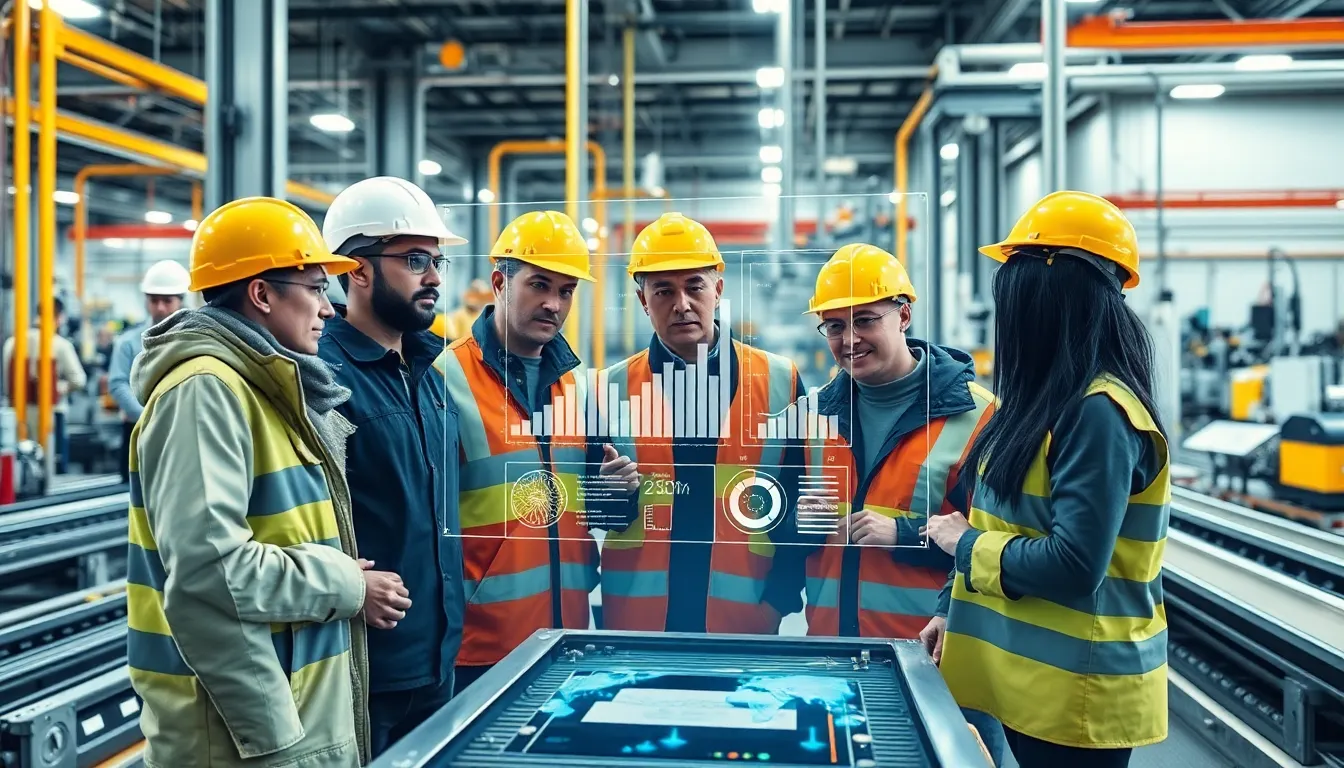In a world where machines are getting smarter and factories are turning into tech-savvy wonderlands, the Industrial Internet of Things (IIoT) is leading the charge. Imagine a factory where your coffee machine knows when you need a caffeine fix and the conveyor belt is more reliable than your morning alarm. That’s not just a dream; it’s the future of manufacturing, and it’s happening right now.
Table of Contents
ToggleOverview of Industrial IoT Trends
Industrial IoT continues to gain momentum, revolutionizing manufacturing processes with advanced technology solutions. Increased connectivity among devices leads to greater data collection, enabling businesses to make informed decisions. Real-time monitoring provides crucial insights into equipment performance, reducing downtime and maximizing productivity.
Adoption of artificial intelligence in IIoT systems enhances predictive maintenance capabilities. Machines can analyze patterns and predict failures before they occur, significantly lowering maintenance costs. Additionally, integration of cloud computing allows for scalable data storage and accessibility, facilitating collaboration across teams.
Cybersecurity remains a top priority. With the growth of connected devices, safeguarding sensitive industrial data becomes essential. Companies invest in robust security measures, ensuring compliance with industry standards and protecting against potential threats.
Edge computing emerges as a notable trend. Processing data closer to where it originates minimizes latency and increases efficiency. This technology is particularly beneficial in environments where immediate data processing is crucial, such as assembly lines.
Sustainability initiatives increasingly influence IIoT implementations. Companies seek to reduce energy consumption and minimize waste, aligning their operations with environmental standards. By utilizing IoT solutions, users can monitor energy usage in real time, enabling them to identify inefficiencies.
The landscape of Industrial IoT continues to evolve with technological advancements, emphasizing efficiency, security, and sustainability. As industries embrace these trends, transformative change shapes the future of manufacturing.
Key Technologies Driving Industrial IoT

Several key technologies drive the Industrial Internet of Things, enhancing manufacturing processes and operational efficiency.
Artificial Intelligence and Machine Learning
Artificial intelligence and machine learning dominate many IIoT applications. These technologies facilitate predictive maintenance, enabling machines to analyze historical data and predict potential failures. Algorithms learn from patterns, resulting in reduced downtime and optimized maintenance schedules. Manufacturers experience increased reliability with smarter systems that adapt to changing conditions. Furthermore, AI enhances decision-making by providing actionable insights based on real-time data. Businesses utilizing AI-powered analysis can significantly lower costs while improving efficiency.
Edge Computing
Edge computing emerges as a critical component in the IIoT landscape. This technology processes data closer to its source, drastically reducing latency in data transmission. Immediate analysis empowers manufacturers to make swift decisions based on current data. Additionally, edge devices operate efficiently even with unstable internet connections, ensuring continuous data flow. Companies benefit from enhanced operational performance as they minimize response times and optimize resource utilization. As a result, edge computing plays a vital role in maintaining efficiency, particularly in environments such as manufacturing and logistics.
Impact on Various Industries
The Industrial Internet of Things (IIoT) significantly impacts various industries, transforming operations and enhancing efficiency.
Manufacturing
Manufacturing benefits immensely from IIoT by streamlining processes and improving resource management. Connected machines provide real-time data on performance metrics, enabling quick responses to operational issues. Enhanced predictive maintenance informs managers of potential equipment failures, reducing downtime. Real-time analytics assists in optimizing production schedules and inventory management. Data-driven insights lead to better decision-making and increased operational efficiency. Additionally, automation technologies integrate into manufacturing lines, minimizing human error and labor costs.
Supply Chain Management
IIoT revolutionizes supply chain management through increased transparency and responsiveness. Real-time tracking systems monitor inventory levels and shipment statuses, ensuring greater visibility throughout the supply chain. Automated alerts help businesses react promptly to disruptions or delays. Enhanced data collection enables predictive analytics for demand forecasting, improving inventory management strategies. Streamlined communication between suppliers and manufacturers enhances collaboration, resulting in reduced costs and more efficient procurement processes. IIoT solutions also promote sustainability by optimizing transportation routes, thus minimizing carbon footprints.
Challenges Facing Industrial IoT Adoption
Adopting Industrial IoT presents several challenges. Addressing these obstacles is vital for successful implementation across industries.
Security Concerns
Cybersecurity significantly impacts Industrial IoT adoption. Risk of cyberattacks increases as more devices connect to networks. Companies face threats such as data breaches and unauthorized access. The sensitive nature of industrial data heightens the need for robust security protocols. Implementing encryption, network segmentation, and regular security audits proves essential for protecting critical infrastructure. Organizations also invest in employee training to recognize and respond to potential cybersecurity threats. Ensuring compliance with regulations offers additional layers of protection. Maintaining a proactive security posture is crucial for safeguarding operational integrity.
Integration Issues
Integration challenges hinder seamless Industrial IoT adoption. Diverse legacy systems often complicate efforts to connect new IoT devices. Compatibility hurdles arise when attempting to merge various technologies. Companies might face difficulties synchronizing data across platforms, leading to inefficiencies. Standardization across devices and protocols simplifies integration. Utilizing middleware solutions eases communication between legacy systems and modern technologies. Industry collaboration can foster development of common frameworks, simplifying integration for users. Addressing these integration obstacles is essential for realizing the full potential of Industrial IoT.
Future Outlook for Industrial IoT Trends
Predictions for Industrial IoT indicate substantial growth through 2025, with a compound annual growth rate projected at 26.4%. Investment in IIoT technologies exceeds $15 trillion globally, underscoring the sector’s increasing importance. Enhanced connectivity among devices represents a key driver, fostering automation and efficiency in manufacturing environments.
Cybersecurity advancements will become essential as more devices connect to networks. Companies will prioritize implementing advanced security measures, such as machine learning-based threat detection, to protect sensitive data. Real-time monitoring solutions may become more robust, supporting industries in making informed decisions quickly.
Artificial intelligence applications are expected to evolve, enabling more sophisticated predictive maintenance capabilities. Data analytics tools will drive actionable insights, allowing organizations to minimize downtime and lower operational costs. A shift toward edge computing is anticipated, optimizing data processing closer to its source and improving response times in critical operations.
Sustainability initiatives may gain even more traction; organizations are likely to focus on resource conservation and waste reduction through real-time energy monitoring. Emerging technologies, such as digital twins and blockchain, will enhance visibility in supply chain management, increasing transparency across operations.
Furthermore, collaboration within the IIoT ecosystem may become vital, as companies partner with technology providers to leverage combined expertise. This cooperative approach can lead to innovative solutions, addressing integration challenges with legacy systems. Standardization efforts will play a significant role in enhancing interoperability among diverse technologies.
As IIoT continues to evolve, companies will refine their strategies to navigate the complexities of implementation. Prioritizing security, efficiency, and sustainability will shape the future landscape of industrial operations, driving consistent advancements in various sectors.
The future of industrial operations is undeniably tied to the advancements in IIoT. As connectivity and data-driven decision-making become central to manufacturing and supply chain management, companies are poised to reap significant benefits. Enhanced predictive maintenance and real-time analytics will not only streamline processes but also drive sustainability efforts.
While challenges remain in security and integration, the commitment to overcoming these hurdles will pave the way for a more efficient and resilient industrial landscape. With substantial growth on the horizon, organizations that embrace these trends will likely lead the charge in innovation and operational excellence. The evolution of IIoT is set to redefine how industries function, making it essential for businesses to stay ahead of the curve.

